The Bronx, New York City, New York: The New York Botanical Garden was founded in 1891 and is designated a National Historic Landmark. It is on my list of top 10 botanical gardens to visit in the United States.
Destined to be spectacular from the start, the Garden was inspired by a visit to the world-famous Royal Botanic Gardens, Kew, near London, England. Think of it as a museum of plants with 50 outstanding living garden collections spread over 250 acres.
Planning a Trip to the NYBG?
Whether you are planning a trip to the New York Botanical Garden or are just interested in seeing it from afar, this post will take you along the path past flowers and through forests. A Garden Travel Guide to the New York Botanical Garden is located at the end of the post. It contains tips for planning your trip, including the best ways to get there and where to eat once on the grounds.
New York Botanical Garden Founders
Distinguished botanists Nathaniel (1875 – 1934) and Elizabeth Britton (1858-1934) were captivated by what they saw and learned at the Kew Gardens. They came back determined that New York should have a similar extraordinary garden that would lead botanical science, house rare and valuable plant specimens, and teach the public to love plants.

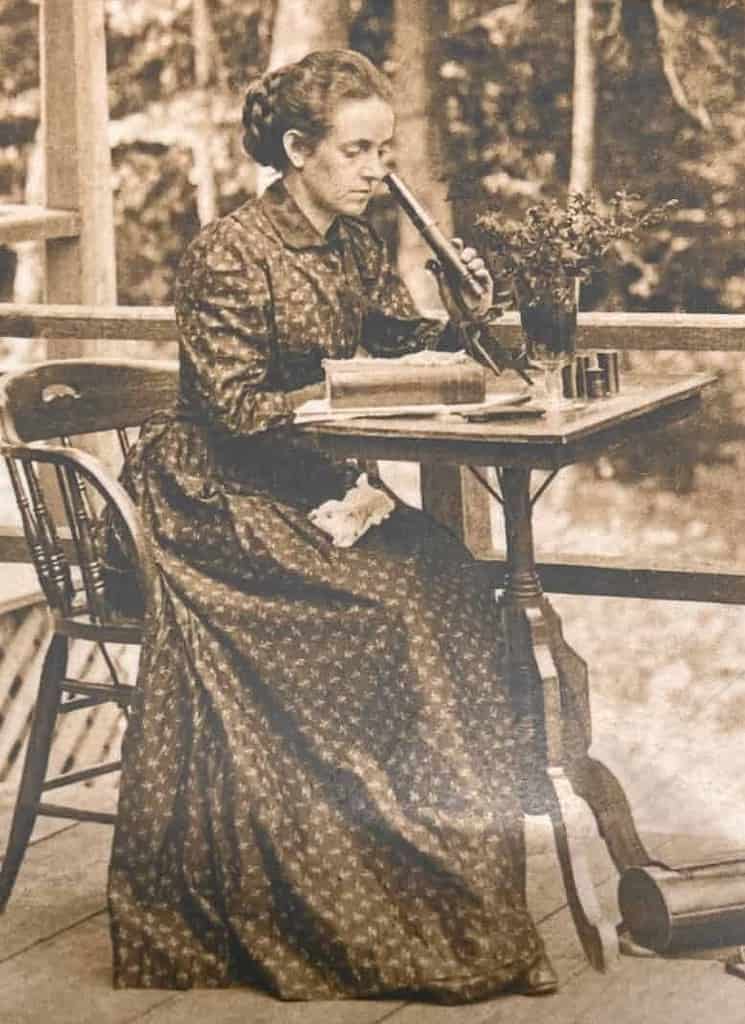
Fast forward a century and a half, and see why the New York Botanical Garden exceeds those expectations.
Museum of Living Plants
With a curated collection representing 40,000 types of plants, The New York Botanical Garden is one of the largest botanical collections in the world and a powerhouse of plant-based research.
Stepping through the garden gates, one leaves behind the crush of the city for sweeping landscapes, colorful flowers, and breathtaking historical buildings.
Herb Garden
Strolling down Perennial Garden Way toward the Conservatory, a charming Herb Garden is the first to draw visitors through its gate.
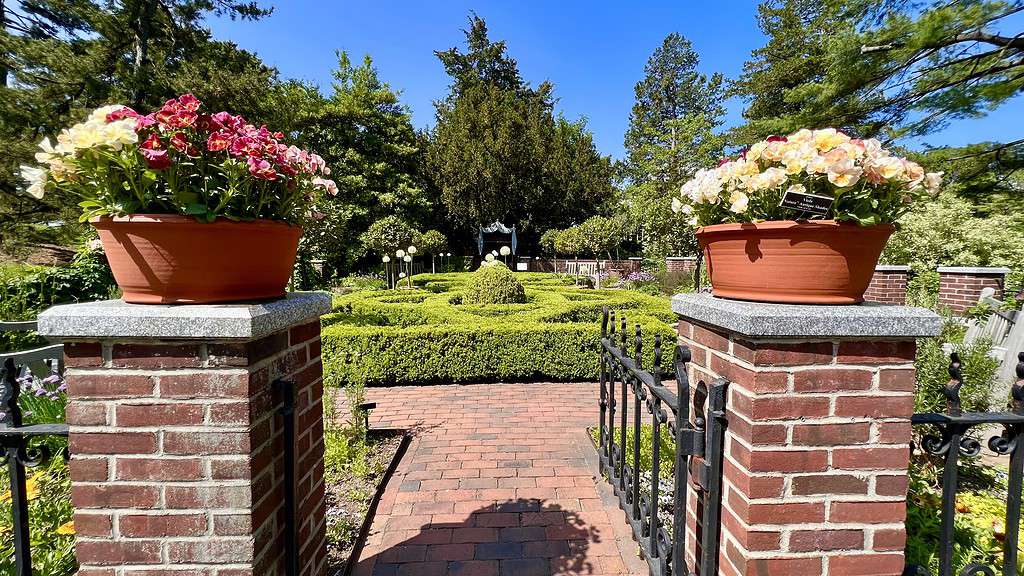
Inspired by English knot gardens of the Tudor Period (1485-1603), the clipped parterres form intricate patterns when viewed from above.
The Auricula Theatre is an interesting addition at the back of the Herb Garden. It was designed in 2007 by Lady Salisbury, one of England’s most revered garden designers.


In the 19th century, British gardeners built cases like this to display delicate auricula Primroses to protect them from wind and rain.
The Theatre was empty, but wouldn’t it be beautiful filled with flowers?
Perennial Garden
The Herb Garden path leads into the Perennial Garden. It is a series of garden “rooms,” each showcasing a unique color or seasonal theme in the style of traditional English mixed borders.
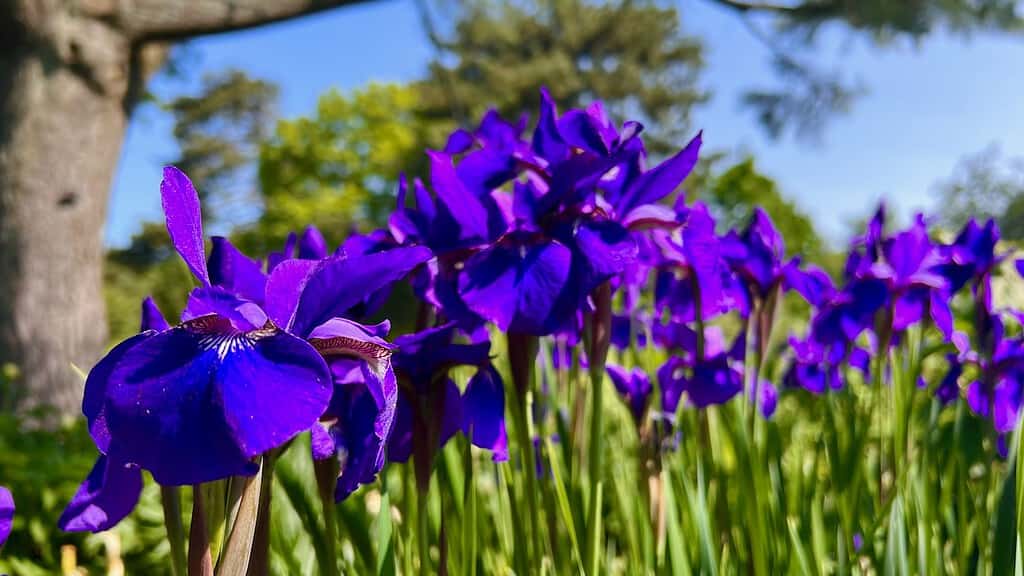
Peony Collection
Stealing the show on the opposite side of the Perennial Garden Way was this stunning peony border with more than one hundred fifty different herbaceous peonies.

Garden-goers can use the Bloom Tracker to plan visits for peak bloom times. The peony blooms peak mid-May.
Enid Haupt Conservatory
The Enid A. Haupt Conservatory is the jewel of the New York Botanical Garden. It is a magnificent glasshouse featuring aquatic plants, lush tropical forests, and cactus under its dome.
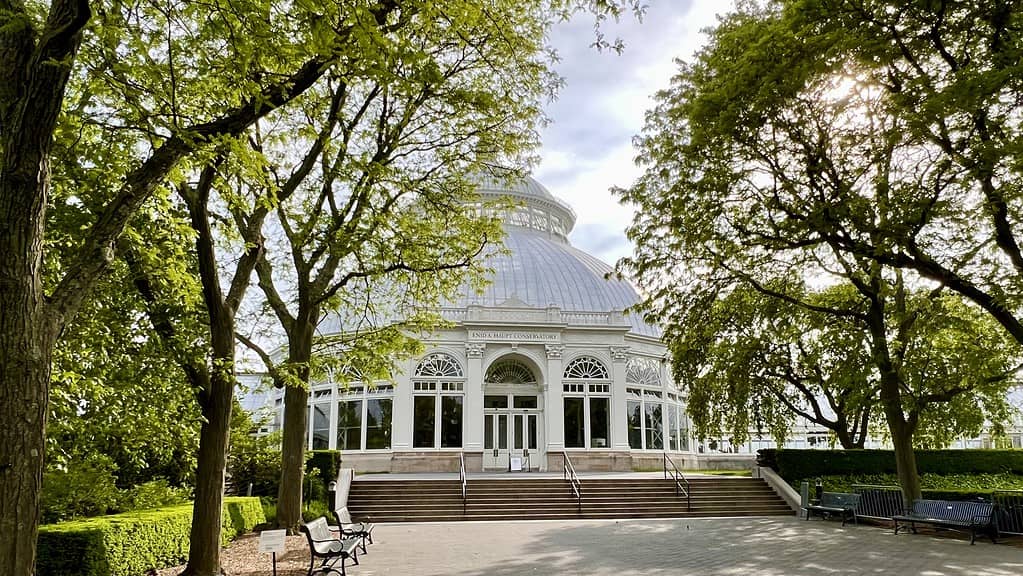
You must buy an All-Garden Pass or be a member of the New York Botanical Garden to enter the Grand Conservatory. Tickets will be requested at the Conservatory and scanned before entering.
The GROUNDS ACCESS PASS for New York residents and the Free Pass for members of the American Horticultural Society do not include the Conservatory or tram. For this reason, I recommend upgrading your ticket to The All Garden Pass.
With 250 acres to cover, The Tram is a useful time and step safer. It whisks visitors around the garden, stopping at every major attraction.
Seasonal Walk
Continuing alongside the Conservatory is a Seasonal Walk with flowing grasses, bulbs, and perennials based on the design of Piet Oudolf, the renowned landscape architect whose designs can be found worldwide.

Oudolf is a leading figure of the “New Perennial” movement whose designs and plants combine drifts of perennials and grasses chosen at least as much for their structure as for their flower color.
The original 2014 Seasonal Walk planting plan by Piet Oudolf is displayed for gardeners to view and use to create their New Perennial garden.
Home Gardening Center
The Home Gardening Center offers inspiration and highlights the best new plants for the home garden.
In the summer garden, the formal design features a symmetrical layout. Clipped hedges, brick paths, and a wrought-iron fence add to the garden’s formal structure, with a mix of bulbs, annuals, and perennials filling the planting beds.
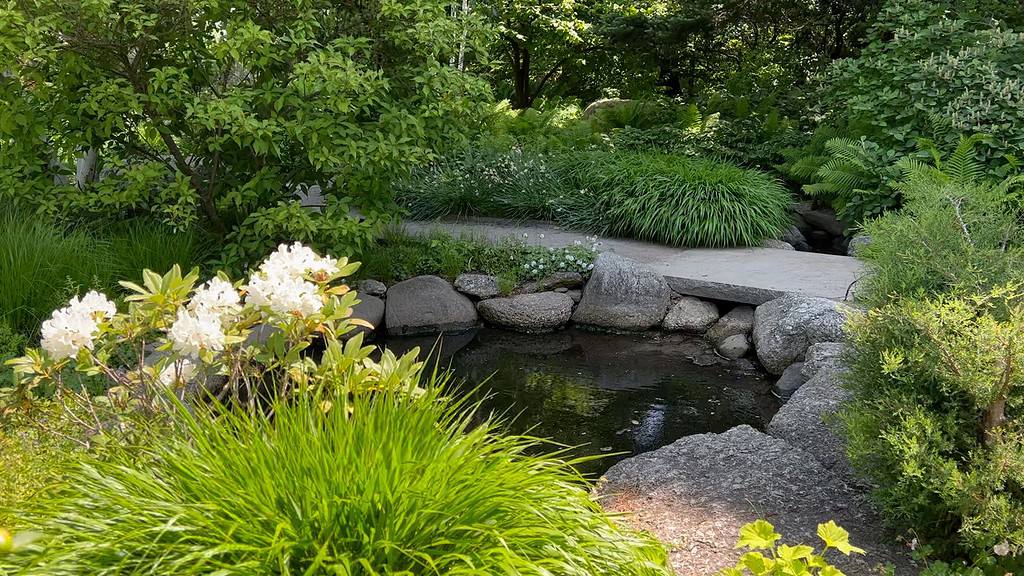
To create a shady woodland in the Country Garden, a limited palette of white flowers and green foliage, along with meandering paths and flowing water, contribute to a peaceful, contemplative space.
Daylily Daffodil Walk
The Daylily/Daffodil walk had neither daylilies nor daffodils in bloom mid-may, but the tall alliums created a whimsical walk to the Library.

Tulip Tree Allée
The Tulip Tree Allee in front of the library dates back to 1903 and is an iconic Garden feature.
Sadly, The trees that once lined this drive have experienced a natural decline. The ailing trees are being removed, and new tulip trees are being planted.

New York Botanical Garden Library
The 1901 library building holds the most extensive botanical library in the Western Hemisphere. The library houses over 750,000 books, historical manuscripts dating back hundreds of years, cookbooks, and even children’s activities.
The sixth floor is open to the public, generally Tuesday to Friday, 10 am to 4 pm. Check the New York Botanical website for the current Metz Library hours.
Newer buildings adjacent to the library now house the renowned scientific facilities of the New York Botanical Garden.
Fountain of Life
The Fountain of Life creates a majestic focal point in front of the Library. Designed by Carl Teft and cast locally by the Roman Bronze Works in Greenpoint Long Island, it was purchased by the City in 1905 for $20,000.
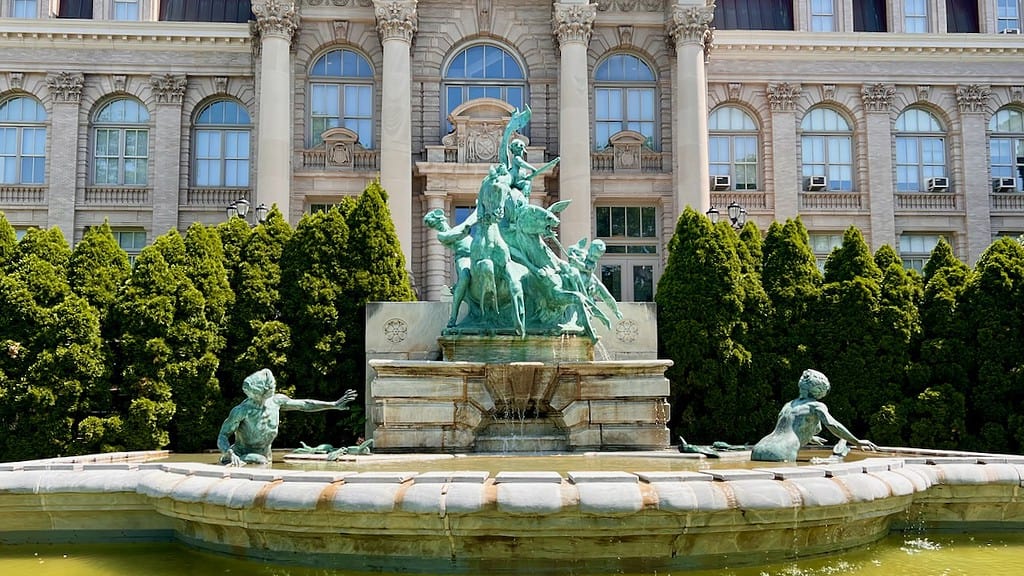
Carl Eugene Tefft, Fountain of Life, 1903-1905 bronze and marble, 10′ x 5′ x 8′ Museum Building entrance.
Daffodil Valley
Hundreds of daffodil varieties are planted throughout The New York Botanical Garden. In the Daffodil Valley, drifts of yellow and white flowers flow down the hillside during the early spring.
Azalea Garden
The Azalea Garden spreads across eight wooded acres and features hundreds of azalea and rhododendron species planted beneath the trees.
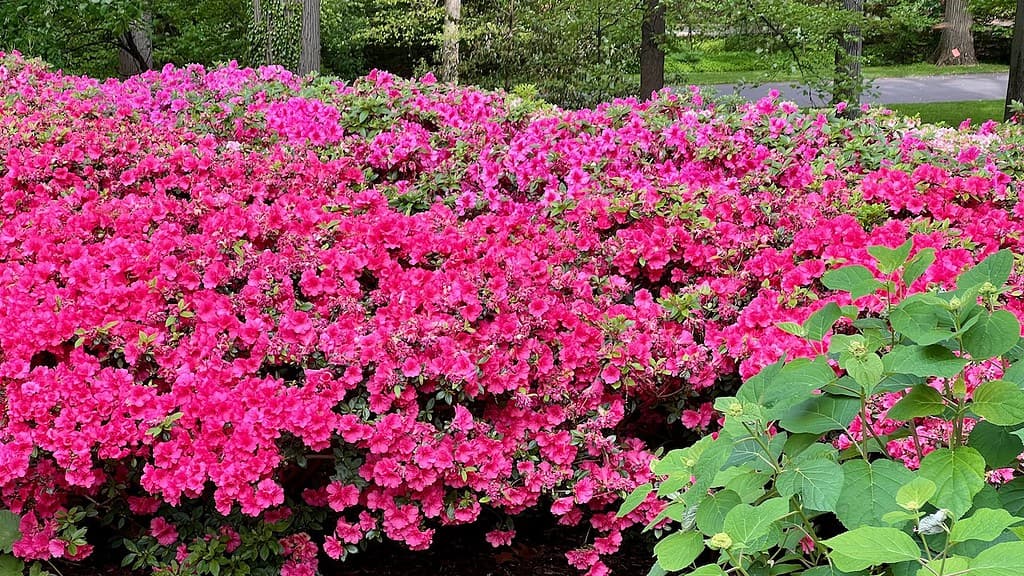
In spring, thousands of azaleas light the hillsides in an explosion of color.
Native Plant Garden
The Native Plant Garden 3-and-a-half acre site has been the location of the native plant display since the 1930s. It was Redesigned and opened in 2013 to feature a variety of beautiful native plants and to learn about their crucial role in local ecosystems.
This is a great place to get ideas for plants to use in your own landscape at home. These native plants are sturdy and adaptable and serve as a sanctuary for wildlife.
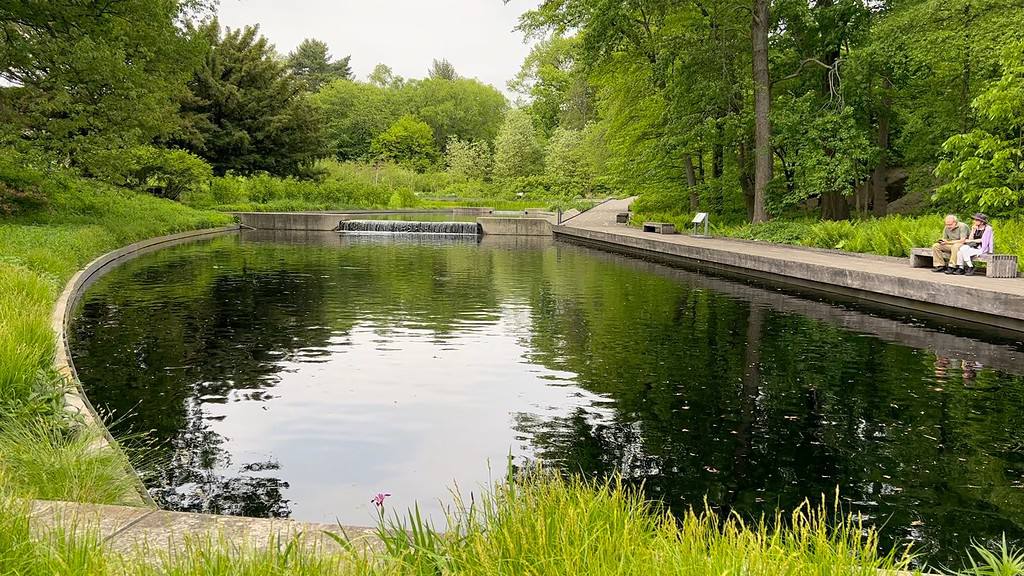
Walking the path, the visitor observes birds, butterflies, and bullfrogs. One could almost forget they are in the middle of the city until the sirens and airplanes sound in the background and combine with birdsong and croaking bullfrogs to create an unusual urban symphony.
The New York Botanical Garden has a long history of documenting, conserving, and displaying the native plants of the northeastern United States. It is a key part of its mission.
Elizabeth Knight Britton (1858-1934), was a founding member of the Wildflower Preservation Society. She championed the preservation and study of wildflowers.
Rock Garden
Built in the 1930s, this is one of the New York Botanical’s oldest gardens.
The rock garden is enclosed to protect the rare and fragile plants. This garden has an intimate feel and blends traditional alpine garden rockeries with a shaded woodland garden.
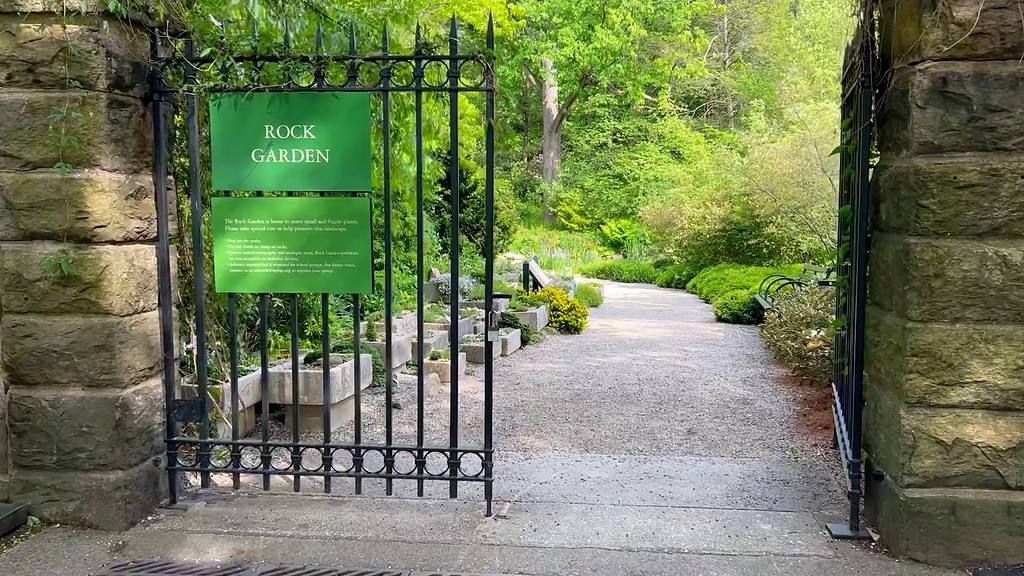
This Garden is one of the only areas of the New York Botanical Garden where boulders were moved and manipulated to create the landscape.
According to the garden signage, in 1932 the garden’s designer, staff, and workers supplied by the federal Works Progress Administration placed nearly every rock in this garden using horses and human strength.
The rocks were arranged to provide planting pockets, beds, and nooks for tiny alpine plants and to simulate high-mountain growing conditions.
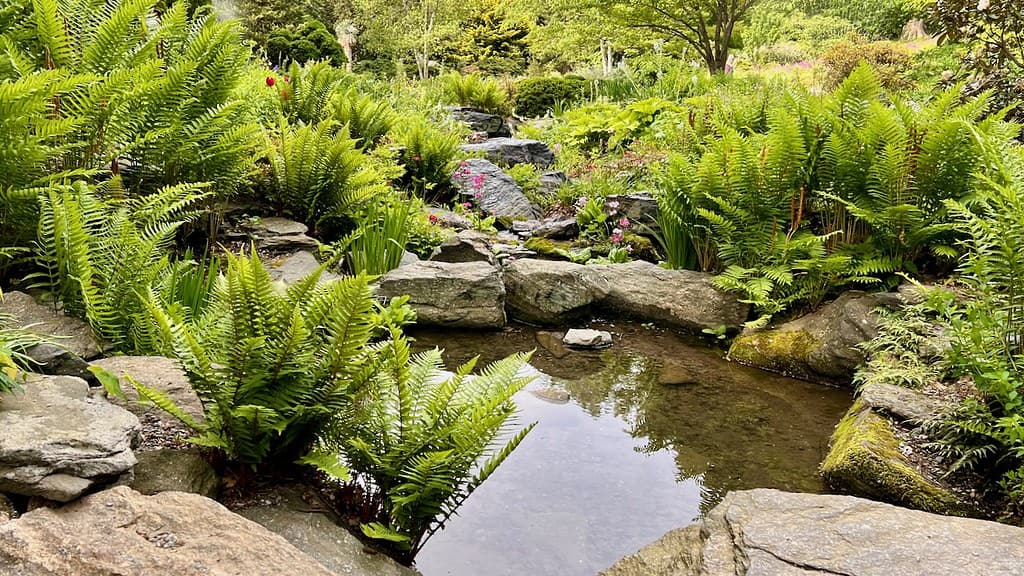
Alpine plants are generally quite small, having adapted to stay close to the ground where it is warmer and has less wind exposure.
Trough gardens are an ideal way to showcase the smaller plants. These miniature gardens feature tiny, jewel-like flowers and intricate foliage forms. Home gardeners can experiment with small plants in similar troughs to create miniature landscapes.
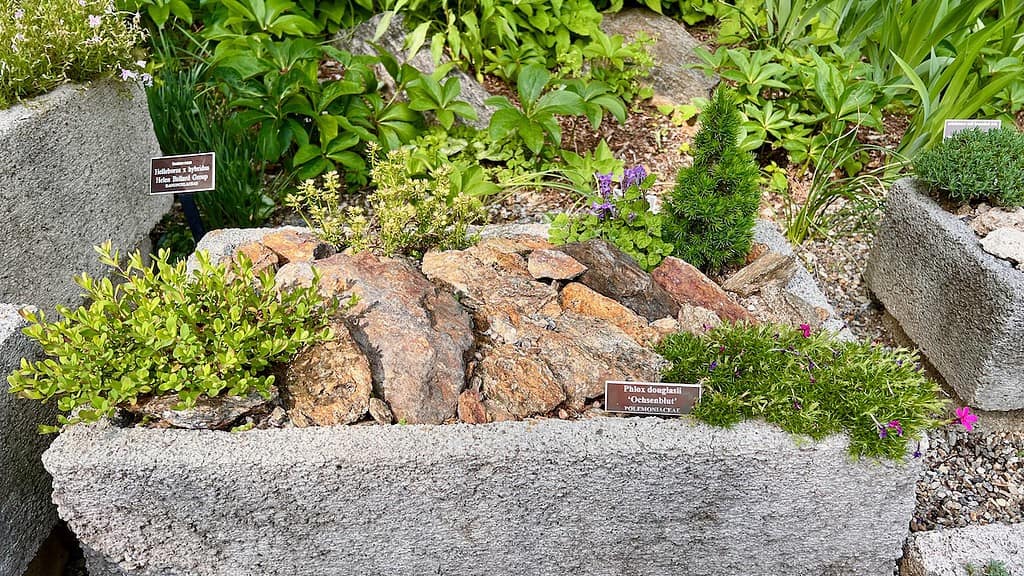
“Alpine and rock plants are tiny treasures of the plant world.”
New York Botanical Garden Signage
The Children’s Adventure Garden
The 12-acre Children’s Adventure Garden encourages children to explore nature actively. There are many fun and engaging activities to explore and learn about the environment.
Kids are encouraged to climb the boulders, pull up water from the pond, water the plants, and adventure down side paths to discover plants, animals, and wetlands.
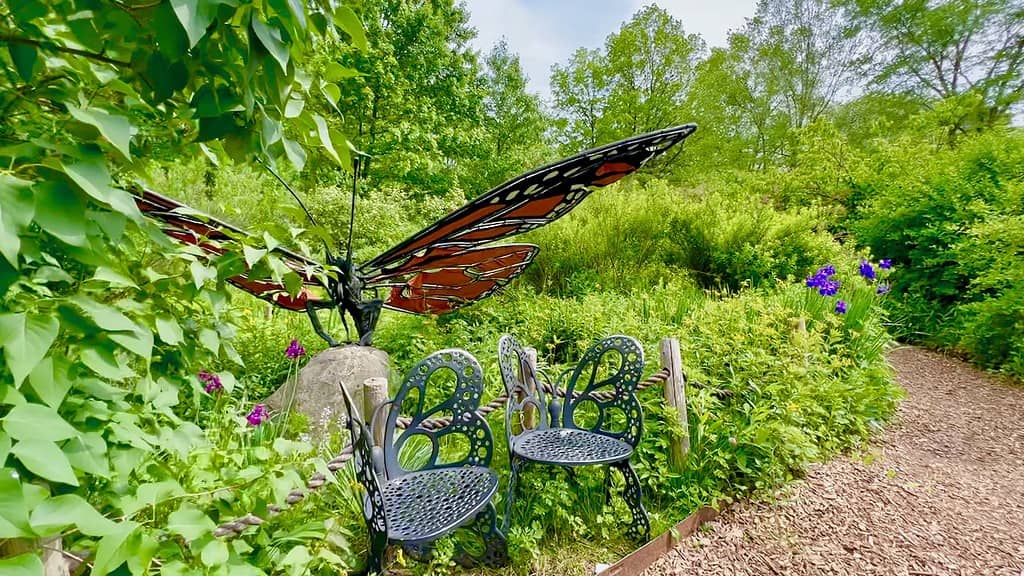
Thain Forest
I recommend meandering through the shaded forest and upper gardens when the sun is hot and high in the sky or when you are ready to escape the groups of people in the formal front gardens.
Founding director Nathaniel Lord Britton (1859-1934) selected this site because it included an ancient forest with healthy populations of native trees, shrubs, and wildflowers.

It seems surreal to be walking through this quiet forest, knowing it is surrounded by the city. While bird song floats through the air, a background of sirens and cars honking brings back the reality of this respite from urban living.
Forest Bathing
Many botanical gardens charge for a Forest Bathing experience, but the New York Botanical Garden provides a meditative audio experience for free.
Visitors may scan a code to access audio tracks and a map to guide them on a tranquil, meditative experience through the forest.

Focusing on slowing down and experiencing the sensory connections that help calm the mind and deepen reflection under the glorious forest canopy of the Thain Forest.
The Stone Mill
The mill was constructed in 1840 to grind tobacco into snuff.
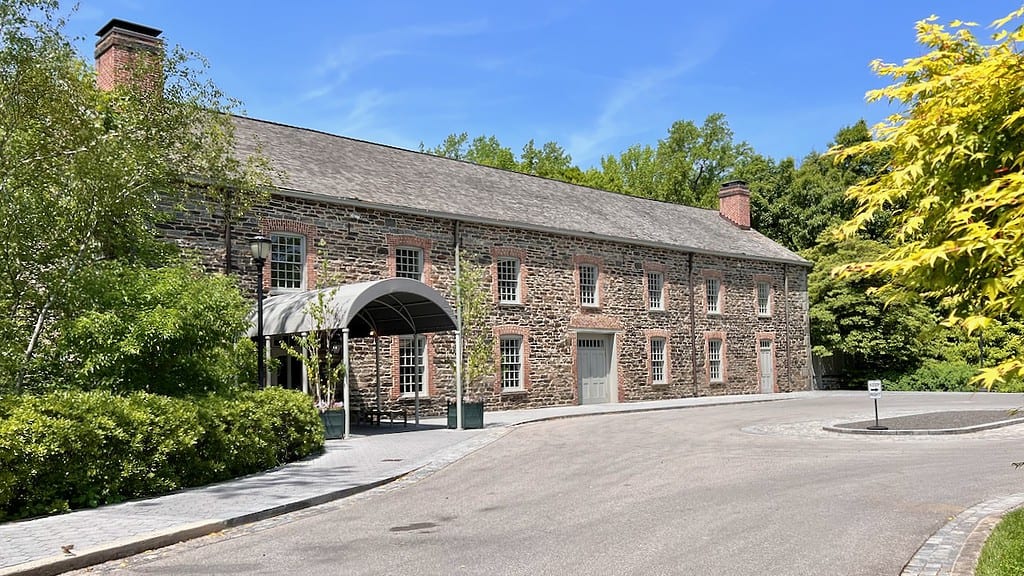
After the City of New York bought the property in the late 1800s, the dam was lowered, and the rocks stacked to achieve the look of a natural cascade.

Edible Academy
The Edible Academy is a living classroom where children, families, and the general public can escape the city and dig in the dirt to learn about the food they eat. Some of the product makes its way into the menu at the onsite Hudson Garden Cafe.
Near the school garden demonstration area, this planted sculpture either welcomes or scares the visitor away. What do you think?

Lilac Collection
Hands down, this was the most fragrant part of the New York Botanical Garden in mid-May.
According to the signage, lilac lovers have flocked to The New York Botanical Garden to see and smell these flowers since 1896.
A favorite in American gardens, this section showcases the lilac shrub’s glorious forms, colors, and scents.

Early, late, and reblooming lilacs heighten the sights and smells through Autumn.
Rose Garden
Designed in 1916, the Rose Garden is one of the only remaining intact gardens designed by Beatrix Farrand (1872-1959), and it was almost lost to history.
Partially completed in 1917, World War I iron shortages made finishing the fence and central gazebo impossible, so the garden was left unfinished during Farrand’s lifetime.

It wasn’t until 1988 that a Garden Board member discovered the original designs and showed them to David Rockefeller, Jr., who then financed the completion of Farrand’s garden.
The Peggy Rockefeller Rose Garden was named after his mother, who loved roses. After she passed away, his father, David Rockefeller, Sr., visited the Rose Garden almost every year on his birthday until he was one hundred years old.
The Rose Garden features more than 3,000 roses representing more than 700 different species, hybrids, and cultivated varieties, and it is a favorite for photographers.
Japanese Maples
The graceful Japanese Maples have an incredible variation in the color and shape of their leaves. Today, there are more than 2,000 named varieties in cultivation around the world.
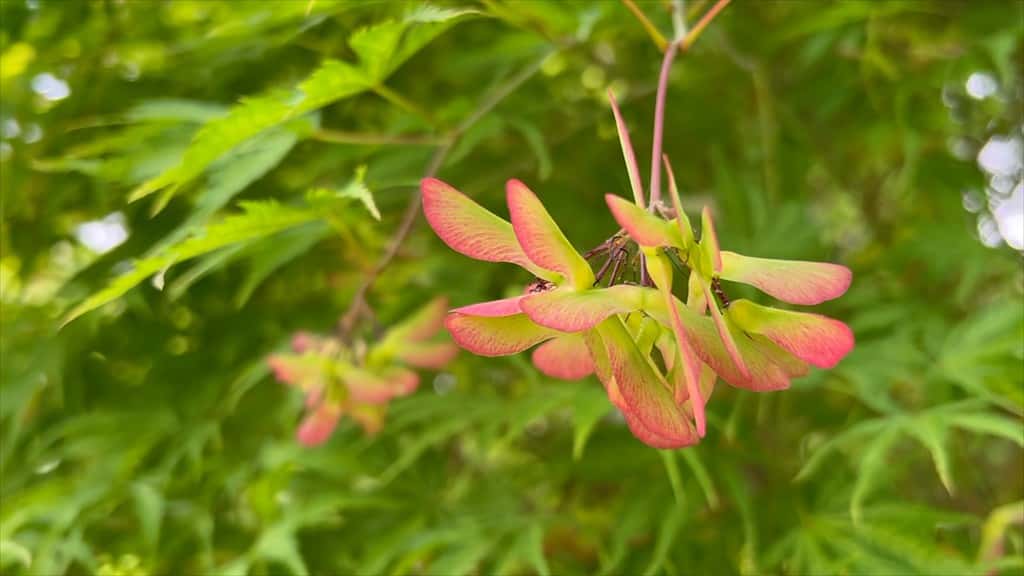
Ornamental Conifers for Gardens
The Ornamental Conifers collection features hundreds of conifers that do well for garden use.

These trees below were planted from seeds in 1950 and play an important role in NYBG’s scientific research.

According to fossil findings, the species dates back more than 100 million years. NYBG botanists use samples from these trees to study plant genetics and evolutionary history.
Relax, Rejuvenate, and Reconnect With Nature
The New York Botanical Garden is a living testament to the power of nature’s beauty and the importance of preserving it for future generations.
Look deep into nature, and then you will understand everything better.
Albert Einstein
Whether you’re a nature enthusiast, an art lover, or simply in search of a peaceful retreat, this botanical haven offers something for everyone. Pack your camera, put on your walking shoes, and get ready to be enchanted by the wonders of the New York Botanical Gardens.
Garden Travel Guide to the New York Botanical Garden

Visitors Guide to the New York Botanical Garden
Address:
2900 Southern Boulevard, Bronx, NY 10458-5126.
How to Best Experience the New York Botanical Garden
Go early. There is a lot of ground to cover. I recommend purchasing an “all-garden pass.”
Make it easy on yourself and take public transportation to the Garden. The Metro-North drops you off directly across the street from the Mosholu entrance.
Plan to meander through the Thain Forest when the sun is high and hot in the sky. You’ll also avoid the formal front gardens as they fill up mid-day.
Plan for lunch and shopping in the garden. The onsite Hudson Grill is excellent, and the gift shop has unique items and an extensive book selection. Make restaurant reservations ahead of time so you won’t be disappointed.
Finally, check the New York Botanical website for events on the day of your visit.
New York Botanical Garden Map
Find the most up-to-date map on the New York Botanical website: NY Botanical Garden Map.
Download the NY Botanical Garden Interactive Mobile Guide to experience the beauty of the Garden while touring the grounds or from the comfort of your home.
New York Botanical Garden Hours
The Garden is open:
- Tuesday to Sunday, 10 a.m.–6 p.m., Tuesday to Sunday
- Closed Monday except federal holidays
The Garden may change the hours with the seasons or for special events. Double-check the NYBG’s website directly before your visit: New York Botanical Garden Hours.
New York Botanical Garden Tickets
All Garden Pass 2023
- Pricing: Adults: $35
- Students (with valid ID)/Seniors (65+): $31
- Children (2-12 years): $15
- Children under 2: Free
NY Botanical Free Day
FREE Wednesdays Grounds Admission*
- All Visitors between 10‒11 a.m.
FREE Grounds Access Pass*
- New York City Residents ONLY
- Available Tuesday – Sunday
American Horticultural Society Members*
- Free Grounds Pass every day.
*Grounds Passes DO NOT include the Tram or the Enid A. Haupt Conservatory. I recommend that you purchase the All Garden Pass.
Check for updates for NYBG Admission Pricing directly on the garden website.
Transportation to the New York Botanical Garden
The New York Botanical Garden is easily accessible by car, public bus, or metro. The NYBG website gives detailed directions on getting to the Gardens.
I took a taxi from mid-town Manhattan, and 5 drivers declined to take the trip. The ride cost over $50.
On the way back, I took the Metro-North Railroad. The “Botanical Garden” station is directly across from the Garden’s Mosholu entrance.
You can purchase metro tickets on your phone: MTA North Schedule to the Garden. I booked my ticket while at the Botanical Garden station. The train ride back to Grand Central Station cost around $7 and took less time than the taxi.
Parking at the New York Botanical Garden
There is onsite parking at the New York Botanical Gardens. Onsite parking is $22 and free for NYBG members.
On busy days, additional Garden parking is available at the New York Botanical Garden Parking Garage which is within a 3-minute walk to the garden.
Detailed parking information for the New York Botanical Garden is on the Garden’s website.
Are Dogs Allowed at the New York Botanical Garden?
Pets are not allowed in the Garden.
Service animals as defined by the ADA are welcome. View the NYBG Service Animal Policy.
Accessibility at the New York Botanical Garden
Much of the Botanical Garden, its buildings, and its tour vehicles are accessible. However, portions of the landscape may be inaccessible due to the Garden’s topography.
The Garden provides an Accessibility Map of the New York Botanical Grounds and strives to provide helpful information to ensure an enjoyable visit for all. See the NYBG website on Accessibility.
Gift Shop
Plant to visit the Gardens gift shop. There are plenty of plants to adopt, a garden book section that is more comprehensive than most local libraries, and garden gifts galore that you’ll want to take home. You can shop the NYBG online, too.
Restaurants at the New York Botanical Garden
Enjoy a break and re-energize at one of the New York Botanical’s onsite restaurants near the front of the Garden.
Hudson Garden Grill
The Hudson Garden Grill provides farm-to-table fare, serving innovative flavors of New American cuisine, including produce from the Garden’s acclaimed Edible Academy. Indoor and outdoor seating. Table Service.
- Tuesdays–Fridays; 11:30 a.m.–3 p.m.
- Weekends and holiday Mondays; 11:30 a.m.–6 p.m.
- Reservations by Open Table
Pine Tree Cafe
The Pine Tree Cafe is near the entrance. It features a family-friendly menu with Sandwiches, pizza, salads, and a coffee bar serving artisanal panini, Neapolitan-style pizza, salads, coffee, and pastries. Stop for lunch or enjoy a coffee and pastry to let your feet recover from traversing the 250-acre garden. Cafeteria style.
Clay Family Picnic Pavilions
Visitors may bring outside food to NYBG to enjoy at the Clay Family Picnic Pavilions.
Mission of the New York Botanical Garden
“The New York Botanical Garden is an advocate for the plant world. The Garden pursues its mission through its role as a museum of living plant collections arranged in gardens and landscapes across its National Historic Landmark site, through its comprehensive education programs in horticulture and plant science, and through the wide-ranging research programs of the International Plant Science Center.”
New York Botanical Garden Website
Website
Other Gardens to See in New York City
While in New York City, don’t miss the High Line in Manhattan. It is the most innovative public park that has gained worldwide acclaim for transforming an unused elevated rail track into a Garden in the Sky. Watch the video below, or read the post The High Line: Freight Trains to Floral Wonder.
Recent Posts
Museums for All in Botanical Gardens and Arboretums Blooming with Access
Museums for All is an initiative that allows individuals and families receiving food assistance (SNAP EBT - Supplemental Nutrition Assistance Program Electronic Benefit Transfer) to gain free or...
San Diego Botanic Garden, Encinitas, CA: The San Diego Botanic Garden in Encinitas is a 37-acre sanctuary about a 30-minute drive north of the city of San Diego. Just a mile from the Pacific...
